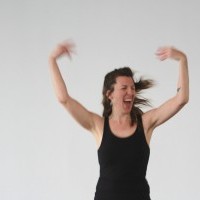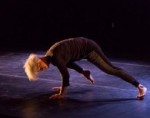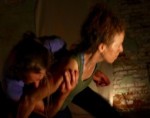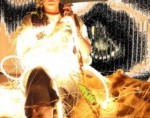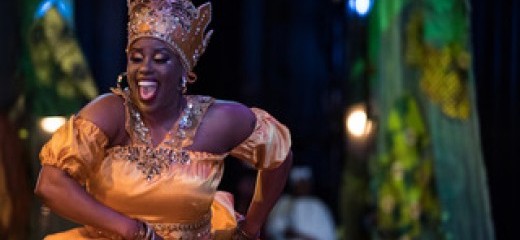
Kulu Mele’s 50-year Spirit of Reciprocation
by Janna Meiring
The 50-year celebration performance of Kulu Mele African Dance and Drum Ensemble begins with a ceremony of pouring libation. One of the two Libators addresses the audience:
“To those who went through ‘The Disaster’—enslavement, apartheid, segregation, and lynching—we say Ashe (Ah-shay); To the freedom fighters, to our personal ancestors, to our mothers and fathers, and to our children. Ashe, Ashe, Ashe.” The auditorium at the Annenberg resonates with a collective “Ashe,” a West African term which affirms what has been invoked. The word makes it so, the word is the power to enact change.
This history-marking event includes a short documentary, followed by the premiere of a dance and drum performance of the Afro-Cuban pataki, or sacred parable, Ogun & the People.
What remains palpable throughout the evening is the lingering dedication; each dance is danced for past and future generations of African descent. Here, I am respectful witness; these dances are not for show, they are powerful invocations of a culture that must thrive for the benefit of our common humanity.
The Ancestors Live - 50 years of Kulu Mele
The 4th in a series by Aidan Un, this documentary film spans the company’s history and legacy, as well as the process for this new performance. The camera descends into Dorothy and John Wilkie’s basement, where Kulu Mele has had a home for more than 30 years. We catch a glimpse of yellowing photos and newspaper cuttings, evidence of the company as a cornerstone of community.
Echoing founder Robert Crowder’s mission to revive African cultural traditions in the US, the Wilkies’ basement has rattled and reverberated with drums and movement, calling up an African spiritual heritage that runs through veins and bones. With the absence of genealogical records, one of the dancers reflects, African dance and music serve as the “technology” for a person “to learn about what we kept as a people” through The Disaster.
As the 50-year marker approached, Dorothy Wilkie, the artistic director and the show’s producer, began the ambitious project to mount Ogun & the People. Eventually the company went to Cuba to receive the pataki through oral tradition with Ballet Folklorico Cutumba in Santiago de Cuba.
Ogun & the People
The Storyteller (Jos Duncan) steps onto the stage and verbally recounts this pataki to us. Describing a cast of orishas—divine beings that represent nature and human characteristics—she emphasizes what might be translated to modern day. Ogun, our story’s central figure, represents ironwork, labor, and hunting—and today, everything from kitchen tools to airplanes. In the crisis of the story, Ogun returns from a long period of work, ready to be received by The People, and instead finds that he has been forgotten. With his pride wounded, he takes it all away—the tools, building structures, and machines—and disappears into the forest. The People are in despair, turning to the other orishas for help in drawing him back out again, so that the world can return to balance.
Now, armed with both context and plot, we receive the story again through dance and music. Four singers and three drummers begin a series of Afro-Caribbean songs that roll one into the next. Each song is of an orisha, indicating an energetic and rhythmic signature, and prioritizing an integrated relationship between dancer, drummer, and vocalist. A single voice calls out, and three respond as the beats ground and propel the dance.
A group of young dancers about 10 to 14 years old, together representing Elegba, the orisha of roads and doors, enter. As they step lightly in bare feet, they roll and bounce their shoulders forward to the rhythm, leaning into each step. Moving in between and around each other, they form lines and pathways that dissolve and reform.
Ogun (James Ali Wilkie) is first paraded in on The People’s shoulders, championed and cheered. He stomps forward on each leg, pulses his chest forward and raises his hands with straight arms in a gesture of disbelief when The People ignore him, then disappears behind shear green fabric panels sewn with shapes of large leaves.
Yemaya (Ama Schley), the goddess of oceans and rivers, is the first orisha to attempt to draw Ogun out. She displays a gentle certainty of her position. Holding the edge of her top layer skirt, trimmed with dark blue and aqua, she flicks the skirt quickly as she turns, rendering the illusion of ocean waves across the stage.
As each dance comes to a close, the tempo slows and the next deity enters and prepares, sparking a roll of applause from the audience—a thank-you to the dance and dancer. Shango (Yusuf Young), god of thunder, tosses each foot back in one rapid click, and draws each arm up along his body.
Oya (Cachet Ivey), warrior and ruler of storms, wind, and fire, puffs her cheeks out and widens her eyes as she waves a whip made of horsehair in a circle of above her head. She slashes in front of her body from side to side as she takes long, forward-leaning strides. Stomping heavily on both feet, a shock moves up her body and jolts her shoulders up and down.
Then, Oshun, goddess of sweetness, love, and sensuality appears. The leading part is played by Crystal Gatling, backed by four additional dancers to show the extension of her powers. Dressed in brilliant honey-gold layers of shimmer and with exposed shoulders, Oshun drops her head back slowly in a delightful and easy laugh. Every move is oozing with sensuality, but not the kind made for other’s eyes. Rather, it is a sensuousness within and of oneself. Oshun, in her wisdom of love, is the one to finally coax Ogun, who returns the tools to The People.
Legacy
As shared in the program, Wilkie envisioned this piece as a response to the current time of civic and cultural crisis and to “enact...[their] ongoing role in carrying the torch for The Culture.”
As folks turn to the African heritage that exists within their bodies, an immense capacity to overcome our complex collective situation emerges: a deep personal love of self and other. Ogun & the People calls out for this African self-love and reverence to those who have come before, in order to root one’s presence in this world, at this time.
At the end of the night, the roomful of people stands on its feet, and Dottie and John Wilkie come down from the singers’ platform to offer gratitude, a 50-years’ constant practice. As they call up the young dancers who opened the show, Dottie Wilkie introduces them as the children of the company and of The Culture, meant to carry the torch.
Ogun & the People, Kulu Mele African Dance and Drum Ensemble, The Annenberg Center, November 30 and December 1.
By Janna Meiring
January 3, 2020

